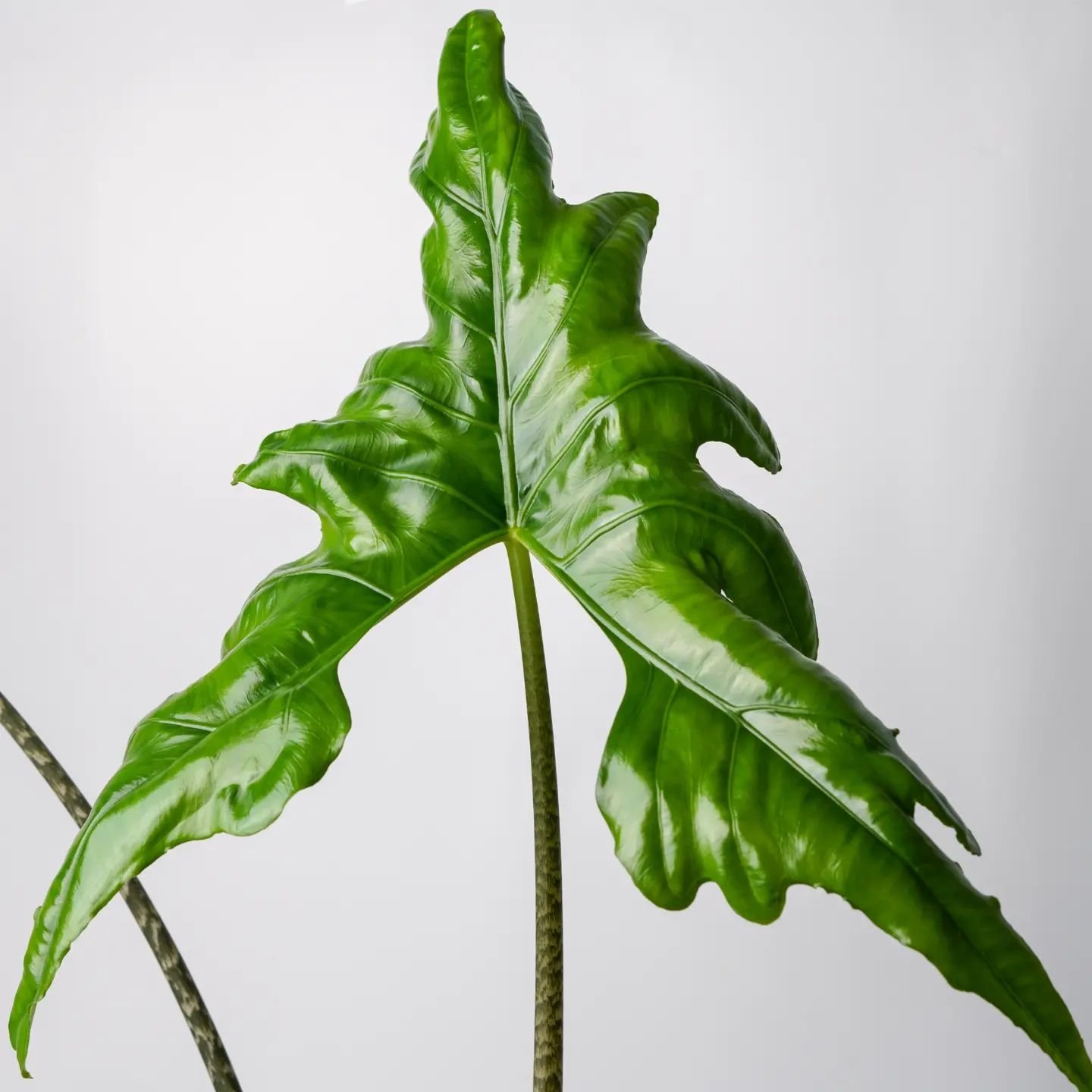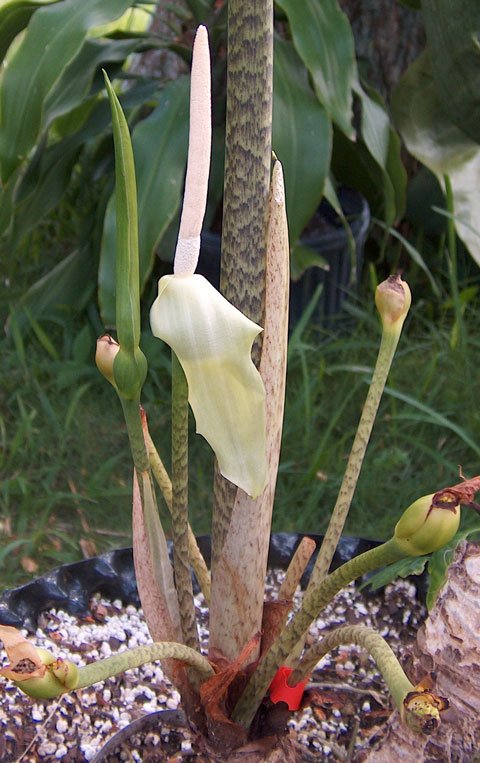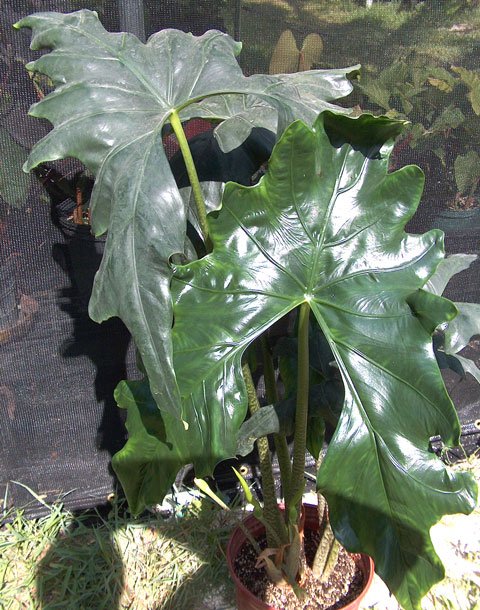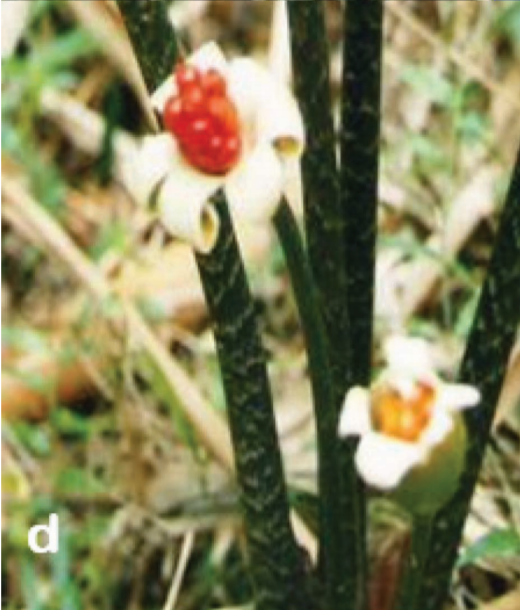ALOCASIA NYCTERIS
ORIGINAL DESCRIPTION:
Alocasia sanderiana arte similis in foliis late sagittatis profunde undulatis, sed spadicis appendice longa, ovario sterilibus irregulariter factis differt.
Alocasia nycteris Medecilo, Yao & Madulid, sp. nov.
Type: PHILIPPINES: Nabas, A 11°54'18"N and '2i°59^3nEt 3 Nov 2005, Medecilo 397 (holotype: PNH; isotypes: DLSU, DLSU-D).
Journal of Botanical Research Institute of Texas V1 N2 (P815-818) (2007)
SYNONYMS: Alocasia advincula, Alocasia ‘Batwing’
DISTRIBUTION: Philippines; Panay Island, Nabas to Ibajay, Aklan and Antique, 0-20 masl.
CLIMATE: Tropical humid climate
Humidity is moderate throughout the year, ranging from 60% to 70%
Temperature is varies between the seasons - within the range of 48°F/9°C to 88°F/31°C during the day. Minimum temperatures never dip below 45°F/7°C
Rainy and humid season (October to May) and a dry season between June and October. The average annual rainfall is 1,200 mm
ECOLOGY: Remnant lowland forests and secondary forests. Common on rocky areas. Prefers shaded places along roadsides. It also grows in disturbed secondary forest near ricefields.
SPECIES DESCRIPTION:
Terrestrial robust herb to 1.5 m tall; stem erect to decumbent, up to 12 cm x 2 cm; L subtended by cataphylls; cataphylls papery, up to 12 cm long by 2 cm wide at base, narro nate; petiole 45-100 cm x 1.5-2.0 cm wide, green with blackish green streaks, sheathe to one-quarter its length, marginally marcescent; blade hastate to sagittate, 20-37 cm x 3 middle, coriaceous, dark glossy green adaxially, paler green abaxially, membranous when undulated to subpinnatifid along margin; anterior lobe widely triangular or deltoid, acum pairs of lateral veins nearly opposite diverging at 60-65° angle on each side of the ante glands conspicuous, brownish green, 0.1 mm diam.; secondary veins very fine, 3 mm the anterior costa and primary lateral veins then abruptly deflected to the margin not for collective veins; posterior lobes diverging at 85°-95° angle, up to 24 cm long; posterior sinus for 3-4 cm, tip rounded, in some leaves forked, with 3 primary veins arising from the posterior costa; inner side of the posterior lobe up to 4 cm wide at the middle, lanceolate.
INFLORESCENCE:
Inflorescence 1 tended by cataphylls; cataphyll whitish green, narrowly ovate, 10-1 2cm x 3-4 cm at the to 2 mm long, thick when fresh; peduncle up to 24 cm long x 1 cm wide at base, light gr at the base; spathe up to 10 cm; lower spathe tube ovoid, light green, 1.5cm x 1cm dia lanceolate, cuculiate, pale yellow, tip acuminate, separated from the limb by a short deep c shorter than the spathe, partly adnate to the lower spathe at 1.5 mm; female zone 10 mm at the middle; ovaries light green, subglobose, 3 mm in diam.; stigma 3-lobed; lobes, e style 0.5 mm long, brownish green; pistillodes reduced, irregular shape with holes in wide, whitish; sterile interstice 5 mm long x 4 mm wide, cylindric; whorl comprised of rhombo-hexagonal synandrodes, 2 mm wide; male 14 x 6 mm, cylindric, whitish green; s to rhombo-hexagonal, slightly wavy at the edges, 1.5-2 mm diam., apical pores capped appendix 40 mm long x 5mm wide, yellow, tapering. Infructescence oblong. Fruit a berry globose, 10 mm diam, orange when mature, 1-3 seeded. Seeds, greenish-black, globular, 2 mm in diam.
VARIEGATED FORMS: N/A
ETYMOLOGY: The specific epithet 'nycteris' alludes to the bat-shaped leaves genus of African and Asiatic bats comprising the hollow-faced bats. The species name "Bat Alocasia." It was recently introduced in the horticultural trade and an indoor or pot plant. It can be easily propagated vegetatively by separation of the rhizomes. It is best grown under shade with adequate water supply. The plant is not only known in local markets, but also in the international markets.
NOTES: Alocasia nycteris resembles Alocasia sanderiana and Alocasia portei to subpinnatifid blade margins. It differs from Alocasia sanderiana by its larger, taller leaves, the broadly triangular, hastate-sagittate blade, longer posterior lobes absence of a silver white midrib and primary lateral veins. The color of the leaves both lower and upper surfaces while Alocasia sanderiana is shiny, deep blackish green purple in the abaxial surface. The species described here was first introduced to the public by an aroid cula during a garden show of the Philippine Horticultural Society, Inc. (PHSI) President of the PHSI featured the species in the International Aroid Society Newsletter and named it Alocasia advincula. The species name, however, could not be considered in accordance with the International Code of Botanical Nomenclature (Greuter et al. 2000) as it is lacking a Latin diagnosis, and there is no rank indicated and no citation of the holotype.
Conservation status. - Plants are still commonly found along roadsides and in private lands near secondary forests. At present the populations along accessible places are under threat because of over collection for horticultural purposes and from habitat destruction. No legal protection is given to the plant at present. Thus, it is highly recommended that appropriate conservation measures are imposed to prevent rapid decline of population. Mass propagation of the plant by tissue culture is an alternative to collection of the plants in the wild. No populational studies have been made and information is lacking about the biology, phenology, pollination and reproductive biology of the species.
CULTIVARS: N/A
HYBRIDS: Alocasia ‘Manta Ray’ (Alocasia ‘Borneo Giant’ x Alocasia nycteris), Alocasia ‘Nyctedora’ (Alocasia odora x Alocasia nycteris)






